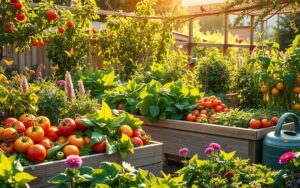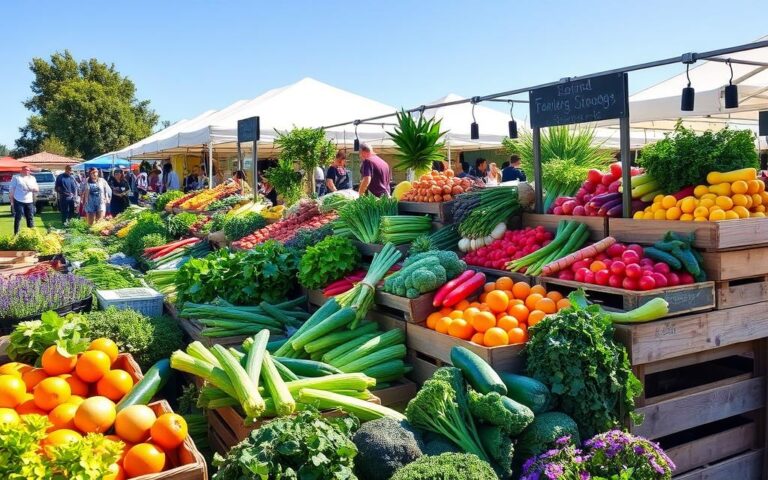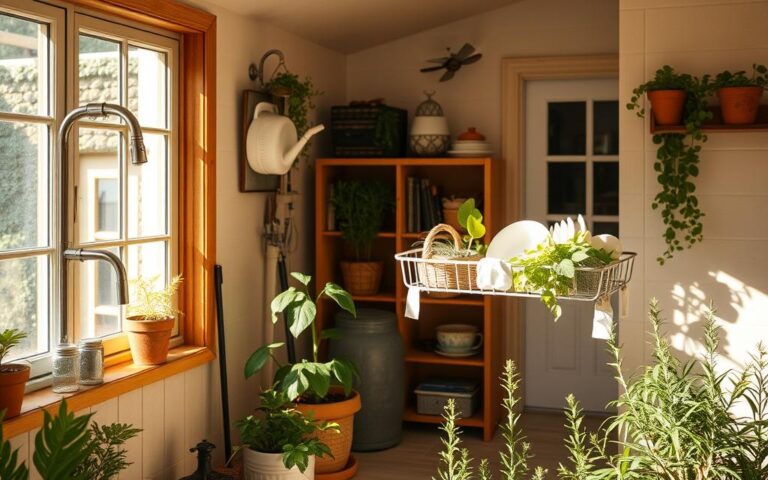Creating an organic vegetable garden at home is more than a trend. It’s a way to live sustainably that helps your health and the planet. Learning how to start one is key as more people choose organic methods. This article gives tips and resources for beginners, like local clubs, books, and online forums.

You’ll learn important steps for organic gardening here. We’ll cover choosing the best spot and understanding soil quality to make your garden thrive. Let’s grow a green space together that supports nature and grows beautiful, homegrown food.
Introduction to Organic Vegetable Gardening
Organic vegetable gardening is about working in harmony with nature. It avoids synthetic chemicals or fertilizers. This method boosts the environment’s health and increases the variety of living organisms.
Good soil and plant health are key. Practices like rotating crops and making compost are central. They keep the soil rich and break pest cycles.
The trend in organic gardening is growing fast. More people see its benefits, like better food and less pollution. This shift towards nature-friendly gardening helps our health and Earth.
Benefits of Organic Vegetable Gardening
Organic vegetable gardening offers more than just benefits for your garden. It can make your veggies safer to eat. By avoiding pesticides, we get fruits and veggies that are full of vitamins and minerals. This boost in nutrition from organic produce is great for improving diets and overall health.
Organic gardening is kind to our planet. It keeps our soil rich and ready for future crops. Practices like rotating crops and using natural ways to control pests make the earth healthier. They increase the variety of life in the soil, helping plants and protecting our water from harmful chemicals.
Gardening organically also means cleaner air and less reliance on chemical fertilizers. When more of us choose to garden this way, it helps fight climate change. Organic gardening supports a greener, healthier earth, matching perfectly with aims to preserve our environment.
Choosing the Right Location for Your Garden
Finding the perfect place for your organic vegetable garden is key for a good yield. Sunlight is crucial for plant growth. Vegetables typically need 6 to 8 hours of sunlight each day. By observing your yard during the day, you can see where sunlight falls most.
The idea of microclimate is also vital for your garden’s success. A microclimate is a small area with different conditions than nearby areas. For example, a wall facing south might be warmer, helping plants that need more heat. It’s important to look at your space’s airflow and how it holds heat.
Being near water is important to keep plants healthy. Make sure your garden is not far from a water source. This makes watering easier. Also, check the soil quality. Testing soil can show what nutrients it has and its pH. This tells you what to add to make your soil better.
- Watch out for things like wildlife and pollution that can affect your garden.
- Think about the slope of your area. Raised beds help with drainage in wet places.
- Use tools to get the most sunlight but protect your garden from strong winds.
With these tips, you’ll create a great environment for your vegetables. It shows you’ve really thought about every part of your organic vegetable garden design.
How to Start an Organic Vegetable Garden
Starting an organic vegetable garden offers the joy of growing your food. First, plan your garden’s layout while considering sunlight and easy access. A smart layout helps use space well and makes gardening smoother.
Choosing the right vegetables is key. Pick organic seeds that grow well in your area. Look for quality seeds from trusted local sources.
Think about how you’ll plant your veggies. Using companion planting, like matching tomatoes with basil, boosts growth and keeps pests away. Also, know when to plant by understanding your area’s frost dates and temperature needs.
To wrap up, starting an organic garden means planning well, picking the right veggies, and using smart planting techniques. This effort creates a garden full of fresh, healthy produce.
Organic Vegetable Garden Soil
Healthy soil is key for a great organic vegetable garden. It is full of nutrients and good microorganisms. These elements are crucial for keeping the soil healthy. A good balance of nitrogen, phosphorus, and potassium helps plants grow well.
Prepare your soil by adding things that make it better. These can make the soil richer and help your garden be stronger. You could use:
- Compost: Adds organic matter to enrich soil fertility.
- Mulch: Keeps moisture in and keeps weeds out.
- Organic fertilizers: Gives plants the nutrients they need.
It’s important to check your soil’s pH and nutrients. You can use a DIY kit or get help from a local service. This helps you know what your soil needs to be healthier. Here’s a list of popular soil testing kits:
| Soil Testing Kit | Features | Price Range |
|---|---|---|
| Rapitest Soil Test Kit | Quick results, tests pH, N, P, K | $10 – $20 |
| Luster Leaf Soil Test Kit | Easy-to-read color chart, tests 3 key nutrients | $15 – $25 |
| Soil Savvy Soil Test | Comprehensive analysis, includes detailed report | $30 – $50 |
Working on your soil health makes your garden grow well. Knowing what your soil needs lets you garden smarter. This means better crops every year.
Organic Vegetable Garden Design
Designing an organic vegetable garden combines different layout strategies. These cater to your space and plants’ needs. Methods include in-ground gardens, raised beds, and vertical options. Each offers its own perks, especially in making gardening more accessible and easier.

Raised beds are a favorite choice for gardeners. They boost space efficiency. Raised beds also enhance drainage and soil warmth, aiding plant growth. Plus, they make accessing your garden for upkeep much simpler, making gardening more fun.
“A well-thought-out garden design can maximize yield and minimize effort.”
To improve your organic vegetable garden, focus on these important points:
- Proper spacing: This gives plants room to grow and ensures good air flow.
- Pathways: Keep your garden easy to navigate. This helps you tend to plants without harming them.
- Sun exposure: Place plants based on their sunlight needs to boost growth all day.
- Companion planting: Select plants that help each other grow. This method also helps with pest control.
Applying these layout strategies will make your vegetable garden both productive and efficient. Thoughtful organization leads to a gardening experience that’s both easy and rewarding.
Best Practices for Organic Vegetable Gardening
Using the best practices for organic gardening leads to a thriving, sustainable garden. Organic methods help keep your vegetables and the environment healthy. Using natural predators and organic repellents reduces chemicals while keeping crops healthy.
Planting a variety of crops helps yields and improves soil health. Rotating crops each year boosts soil fertility and stops pests. Adding compost or organic fertilizers is key for plant growth and productivity.
Knowing about organic certificates is useful for gardeners. These certificates show the produce is sustainable and high quality. By following these guidelines, gardeners can improve their reputation and reach local markets.
| Best Practice | Description | Benefits |
|---|---|---|
| Integrated Pest Management | A holistic approach utilizing natural predators and organic repellents. | Reduces chemical use, promotes crop health. |
| Diverse Crop Planting | Growing a variety of plants to boost resilience. | Prevents diseases and pests, enhances ecosystem health. |
| Soil Replenishment | Adding organic matter and compost regularly. | Improves soil fertility, fosters healthy plants. |
| Organic Certification | Adhering to guidelines that qualify for organic status. | Builds trust with consumers, increases marketability. |
Implementing these best practices can make your vegetable garden a success. It also helps your community’s sustainability efforts.
Watering and Irrigation Techniques
Effective watering is crucial for a thriving organic vegetable garden. Various irrigation methods can enhance plant growth while conserving water. Drip irrigation stands out as one of the most efficient techniques. It directs water straight to the plant roots, minimizing evaporation and runoff.
Another sustainable practice is rainwater harvesting. This method captures and stores rainwater for later use. It reduces dependency on municipal water sources and promotes environmental stewardship.
To determine optimal watering times and amounts, consider these watering tips:
- Check soil moisture: Insert your finger about an inch deep into the soil. If it feels dry, it’s time to water.
- Water early in the morning or late in the evening to reduce evaporation caused by the sun.
- Use a timer for drip systems to ensure consistent and adequate watering.
Mulching can significantly retain moisture in your organic vegetable garden. A layer of organic mulch helps regulate soil temperature. This reduces the need for frequent watering.
Understanding local weather patterns guides your watering schedule. During hot, dry spells, plants may need more watering. Cooler, overcast days may lengthen the time between watering.
Organic Vegetable Garden Maintenance
Maintaining an organic vegetable garden means dedication. It involves well-planned actions to keep plants healthy and abundant. Organic vegetable garden maintenance is key for a flourishing garden.
At the core of maintaining your garden are smart weeding strategies. Weeds steal nutrients and water, so getting rid of them regularly is crucial. You can:
- Hand-pulling
- Mulching
- Using landscape fabric
These methods don’t just fight weeds. They also help the soil as organic matter breaks down. Using these approaches improves your garden’s health.
Another tip is focusing on seasonal duties. You should:
- Check plants for pests often
- Rotate crops with the season
- Change watering based on the weather
Doing these seasonal activities keeps growing conditions ideal. Tools like hand tools for weeds and moisture meters for water make work easier.
Staying on top of these tasks helps gardeners adjust their methods. A steady maintenance plan leads to a healthier, more giving garden.
Organic Vegetable Garden Pests
Maintaining an organic vegetable garden means you’ll face pests. Knowing about organic vegetable garden pests is key for good crops. Check your garden often and catch pests early to stop big problems.
Choosing pest control methods that fit organic gardening is smart. This way, you protect good bugs while fighting pests. Here are several natural ways and strategies to keep your garden safe from pests:
- Beneficial Insects: Bring in ladybugs and lacewings to eat aphids and other bad bugs.
- Homemade Traps: Catch and kill soft-bodied insects with soapy water.
- Companion Planting: Grow marigolds or basil near your veggies to naturally keep pests away.
- Neem Oil: Use neem oil spray to keep many garden pests at bay.
- Diatomaceous Earth: Put this powder around plants to stop soft-bodied pests.
Good pest control means consistently watching for signs of pests. You can learn to spot specific pests and their effects on plants from local services or gardening books. By using these strategies, your organic garden can flourish.
| Pest | Identification | Pest Control Method |
|---|---|---|
| Aphids | Small, soft-bodied insects, often green or black. | Introduce ladybugs; use insecticidal soap. |
| Spider Mites | Tiny, web-spinning pests, usually found under leaves. | Increase humidity; spray with water. |
| Caterpillars | Larval stage of moths and butterflies, often green or striped. | Handpick; apply Bacillus thuringiensis (Bt). |
| Whiteflies | Small, white, moth-like insects on the underside of leaves. | Use yellow sticky traps; release parasitic wasps. |
Using these pest control methods and natural remedies lets gardeners keep their gardens healthy and fruitful. This way, your garden stays free from pests’ bad effects.
Harvesting Your Organic Vegetables
It’s key to harvest organic vegetables when they’re at their best. Each vegetable has its own perfect time to be picked. This depends on how they grow and the weather. Checking on them often helps you pick them at the perfect time. This makes sure they taste great and are healthy.
Here’s how to know the right time to pick some popular vegetables:
- Tomatoes: Pick them when they’re fully colored and a bit firm.
- Zucchini: Best when they’re small, about 6-8 inches long.
- Carrots: They taste best when young, about 1 inch across.
- Leafy greens: Keep picking the big outer leaves to keep them growing.
How you handle your veggies after picking them is super important. Doing it right keeps them fresh. Here are some tips for doing so:
- Wash them gently to get the dirt off without damaging them.
- Make sure they’re dry before you store them to prevent mold.
- Keep them in a cool, dark place to help them last longer.
To have veggies all season, try planting seeds at different times. Joining local markets or CSA programs is a great idea. It lets you share or sell what you grow. Plus, it brings people together.
Community Support for Organic Gardening
Getting involved with the community makes organic vegetable gardening even better. Local gardening clubs are great for gardeners of all levels to share and learn. These clubs offer workshops that give tips suited for the local weather and soil.
Being part of community events helps gardeners connect. Farmer’s markets are perfect for sharing crops and talking about organic methods. Here, new gardeners can get tips from experienced farmers on how to plant and handle pests.
Online forums for organic gardening are also key. They help people come together and support each other by talking about their gardening journeys. Members can post questions, get advice, and share their gardening wins.
Think about joining a local gardening club or going to community events. This will not just boost your gardening skills. It also makes the community stronger, building a supportive network for everyone who loves organic gardening.
Conclusion
Starting an organic vegetable garden is more than a hobby. It’s a pledge to eco-friendly living that rewards both you and the earth. We’ve covered key points like picking the right soil, designing your garden, and upkeep methods. These steps are crucial for a successful vegetable garden.
This journey teaches us that gardening blends art with science. And every step offers new insights into this fascinating process.
To wrap up, having an organic garden lets you enjoy fresh veggies without chemicals. It also brings you closer to nature. Starting this journey means you’re always learning.
Use resources like local clubs, workshops, and online classes to get better. They can teach you a lot.
Join the organic gardening adventure. It promotes both personal growth and a green lifestyle. It helps you learn about where your food comes from. Plus, it supports health, wellness, and caring for our planet.
FAQ
What are the best practices for organic vegetable gardening?
Good practices for organic vegetable gardening include using natural soil enhancers. These are things like organic compost. You should also rotate your crops each year. This avoids depleting the soil.
Using natural methods to deal with pests is important. So is keeping the soil healthy by composting. It helps to weed regularly and mulch to keep moisture. Choosing plants that don’t easily get diseases is key too.
How do I start an organic vegetable garden?
First, pick a spot that gets a lot of sunshine. Plan how you want your garden to look. Then, get organic seeds or plants that are ready to grow. Get your soil ready with compost and other natural stuff.
Consider planting certain plants together. This is called companion planting. It helps with space and keeps bugs that help your garden around.
What are the benefits of having an organic vegetable garden?
Organic gardening cuts down your contact with artificial pesticides and fertilizers. Eating fresh veggies is healthier. Your soil gets better, and so does the variety of plants and animals in your garden.
This way of gardening is kind to our planet. It uses methods that do not harm the environment.
How can I deal with organic vegetable garden pests?
To handle pests in an organic garden, use natural solutions. Plant certain plants together to keep pests away. Bring in bugs that eat the pests. You can also make traps or use organic sprays.
Check your plants often to catch pests early. This helps keep them under control.
What should I consider when designing my organic vegetable garden?
Think about how much sun the garden will get and how you can get water to it. Decide if you want raised beds or to plant directly in the ground. Make sure to leave space for air to move.
Adding paths can make it easier to take care of the garden and to pick your vegetables.
How do I maintain my organic vegetable garden throughout the season?
Keep your garden weed-free and watch out for pests and diseases. Change what you plant each season. Add natural stuff to the soil when needed. It’s helpful to write down what you do in a gardening journal.
This lets you keep track of how your garden does over time.
What type of soil is best for an organic vegetable garden?
The perfect soil for an organic garden has lots of organic matter, drains well, and is pH balanced. You can make it better by adding compost, old manure, and organic food for plants.
This makes the soil healthy and gives your plants the nutrients they need.
How do I harvest my organic vegetables properly?
To pick your veggies the right way, find out the best time to harvest each type. You want them to taste good and be full of nutrients. Use clean and sharp tools to cut them.
Be gentle with your veggies after picking them. This helps keep them fresh.
Where can I find community support for organic gardening?
You can find support in local gardening groups, online chats, farmer’s markets, and classes. Talking to other gardeners is great. You can share tips, resources, and support with each other for better gardening.




